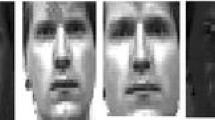Abstract
In this paper, a novel dimensionality reduction algorithm called projection-optimal local Fisher discriminant analysis (PoLFDA) is proposed in order to address the multimodal problem. Novel weight matrices defined on the projected space can represent the intraclass compactness and the interclass separability. Based on the novel weighted matrices, the local between-class scatter matrix and the local within-class scatter matrix are defined such that the local structure can be preserved. In order to enhance the discriminant ability, we impose an orthogonal constraint on the objective function, which can be regarded as a trace ratio problem. In general, a trace ratio problem does not have a closed-form solution; however, it can be solved using some efficient iterative algorithms. Therefore, we optimize the projection matrix by solving the trace ratio problem iteratively. Experiments on toy data, face, and handwritten digit data sets are conducted to evaluate the performance of PoLFDA; the results and comparisons verify the effectiveness of the proposed method.







Similar content being viewed by others
References
Turk MA, Pentland AP (1991) Eigenfaces for recognition. J Cogn Neurosci 3(1):71–96
Fukunaga K (1991) Introduction to statistical pattern recognition, 2nd edn. Academic Press, New York
Belhumeur PN, Hespanha JP, Kriegman DJ (1997) Eigenface vs. Fisherface:recognition using class specific linear projection. IEEE Trans Pattern Anal Mach Intell 19(7):711–720
Yu H, Yang J (2001) A direct LDA algorithm for high-dimensional data with application to face recognition. Pattern Recognit 34(10):2067–2070
Chen LF, Liao HY, Lin JC, Ko MT, Yu GJ (2000) A new LDA based face recognition system which can solve the small sample size problem. Pattern Recognit 33(10):1713–1726
Chu D, Thye ST (2010) A new and fast implement for null space based linear discriminant analysis. Pattern Recognit 43(4):1373–1379
Tenenbaum J, Silva V, Langford J (2000) A global geometric framework for nonlinear dimensionality reduction. Science 290(5500):2319–2323
Roweis ST, Saul LK (2000) Nonlinear dimensionality reduction by locally linear embedding. Science 290(5500):2323–2326
Belkin M, Niyogi P (2003) Laplacian eigenmaps for dimensionality reduction and data representation. Neural Comput 15(6):1373–1396
Zhang Z, Zha H (2004) Principle manifolds and nonlinear dimensionality reduction via tangent space alignment. SIAM J Sci Comput 26(1):313–338
He XF, Yan SC, Hu Y, Niyogi P, Zhang HJ (2005) Face recognition using Laplacianfaces. IEEE Trans Pattern Anal Mach Intell 27(3):328–340
Cai D, He XF, Han JW, Zhang HJ (2006) Orthogonal Laplacianfaces for face recognition. IEEE Trans Image Process 15(11):3608–3614
He XF, Cai D, Yan SC, Zhang H (2005) Neighborhood preserving embedding. In: Tenth IEEE international conference on computer vision, Beijing, China, pp 1208–1213
Zhang T, Yang J, Zhao D, Ge X (2007) Linear local tangent space alignment and application to face recognition. Neurocomputing 70:1547–1553
Li X, Lin S, Yan S, Xu D (2008) Discriminant locally linear embedding with high-order tensor data. IEEE Trans Syst Man Cybern Part B 38(2):342–352
Yu W, Teng X, Liu C (2006) Face recognition using discriminant locality preserving projections. Image Vis Comput 24(3):239–248
Zhang TH, Huang KQ, Li XL, Yang J, Tao DC (2010) Discriminative orthogonal neighborhood-preserving projections for classification. IEEE Trans Syst Man Cybern Part B 40(1):253–263
Yan S, Xu D, Zhang B, Zhang H, Yang Q, Lin S (2007) Graph embedding and extensions: a general framework for dimensionality reduction. IEEE Trans Pattern Anal Mach Intell 29(1):40–50
Cai D, He X, Zhou K, Han J, Bao H (2007) Locality sensitive discriminant analysis. In: Proceedings of international joint conference on artificial intelligence, Hyderabad, India, pp 708–713
Chen HT, Chang HW, Liu TL (2005) Local discriminant embedding and its variants. In: IEEE computer society conference on computer vision and pattern recognition, vol 2, pp 846–853
Sugiyama M (2007) Dimensionality reduction of multimodal labeled data by local Fisher discriminant analysis. J Mach Learn Res 8:1027–1061
Wang H, Yan S, Xu D, Tang X, Huang T (2007) Trace ratio versus ratio trace for dimensionality reduction. In: IEEE computer society conference on computer vision and pattern recognition. Minneapolis, pp 1–8
Jia Y, Nie F, Zhang C (2009) Trace ratio problem revisited. IEEE Trans Neural Netw 20(4):729–735
Zhang LH, Liao LZ, Ng MK (2010) Fast algorithms for the generalized Foley–Sammon discriminant analysis. SIAM J Matrix Anal Appl 31:1584–1605
Zhang LH, Liao LZ, Ng MK (2013) Superlinear convergence of a general algorithm for the generalized Foley–Sammon discriminant analysis. J Optim Theory Appl 157(3):853–865
Zhao MB, Zhang Z, Chow WS (2012) Trace ratio criterion based generalized discriminative learning for semi-supervised dimensionality reduction. Pattern Recognit 45(4):1482–1499
Ngo TT, Bellalij M, Saad Y (2010) The trace ratio optimization problem for dimensionality reduction. SIAM J Matrix Anal Appl 31:2950–2971
Zhang Z, Chow WS, Zhao MB (2013) Trace ratio optimization-based semi-supervised nonlinear dimensionality reduction for marginal manifold visualization. IEEE Trans Knowl Data Eng 23:1148–1161
Zelnik-Manor L, Perona P (2005) Self-tuning spectral clustering. In: Advances in neural information processing systems, pp 1601–1608
Nocedal J, Wright S (2006) Numerical optimization, 2nd edn. Springer, Berlin
Samaria FS, Harter AC (1994) Parameterisation of a stochastic model for human face identification. In: Second IEEE workshop on applications of computer vision, pp 138–142
Lee KC, Ho J, Kriegman DJ (2005) Acquiring linear subspaces for face recognition under variable lighting. IEEE Trans Pattern Anal Mach Intell 27(5):684–698
Hull J (1994) A database for handwritten text recognition research. IEEE Trans Pattern Anal Mach Intell 16(5):550–554
LeCun Y, Bottou L, Bengio Y, Haffner P (1998) Gradient-based learning applied to document recognition. Proc IEEE 86(11):2278–2324
Acknowledgments
This work was supported partly by the National Natural Science Foundation of China (61172128, 61003114), National Key Basic Research Program of China (2012CB316304), the fundamental research funds for the central universities (2013JBM020, 2013JBZ003), Program for Innovative Research Team in University of Ministry of Education of China (IRT201206), and Doctoral Foundation of China Ministry of Education (20120009120009).
Author information
Authors and Affiliations
Corresponding author
Rights and permissions
About this article
Cite this article
Wang, Z., Ruan, Q. & An, G. Projection-optimal local Fisher discriminant analysis for feature extraction. Neural Comput & Applic 26, 589–601 (2015). https://doi.org/10.1007/s00521-014-1768-9
Received:
Accepted:
Published:
Issue Date:
DOI: https://doi.org/10.1007/s00521-014-1768-9




